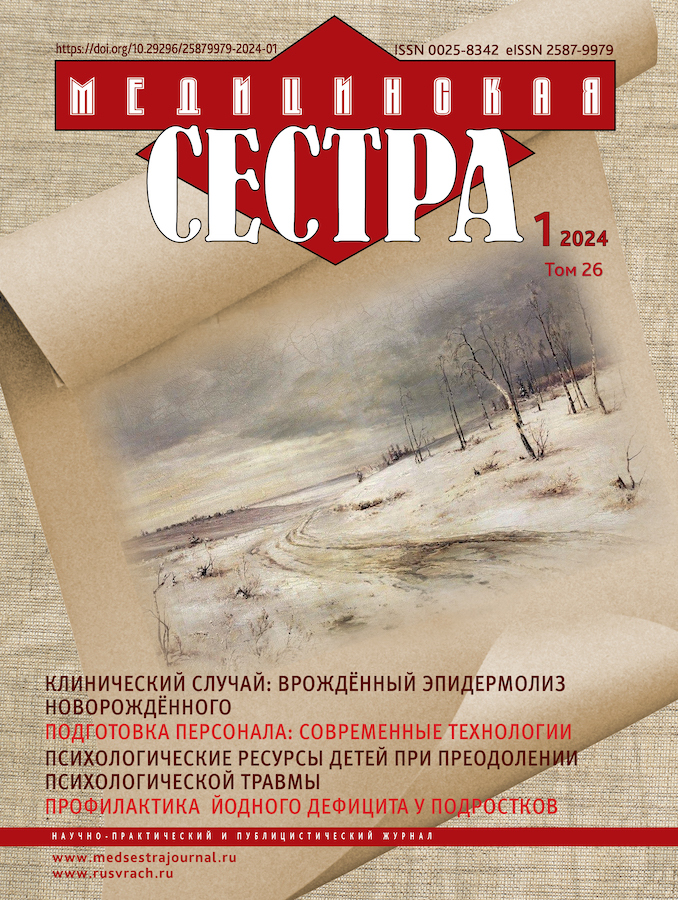Clinical case of congenital epidermolysis bullosa in a newborn
- Authors: Shipilova L.M.1, Chernenkov Y.V.1, Osipova V.A.1, Starchikova T.A.2
-
Affiliations:
- Federal State Budgetary Educational Institution of Нigher Education «V.I. Razumovsky Saratov State Medical University» ofthe Ministry of Healthcare ofthe Russian Federation
- Saratov City Clinical Hospital No. 8
- Issue: Vol 26, No 1 (2024)
- Pages: 23-25
- Section: Клинический случай
- URL: https://journals.eco-vector.com/0025-8342/article/view/629503
- DOI: https://doi.org/10.29296/25879979-2024-01-06
- ID: 629503
Cite item
Abstract
Congenital epidermolysis bullosa (VBE) is a group of hereditary orphan genodermatoses, phenotypically and genetically heterogeneous, characterized by the formation of blisters intradermally and subdermally on the skin and mucous membranes at the site of minimal pressure or friction. The frequency of occurrence is 1:50,000 and depends on the population. VBE affects both boys and girls equally. Inheritance occurs according to the autosomal dominant and autosomal recessive type. The pathogenesis is based on mutations in genes encoding structural proteins of the epidermis, which lead to lysis of keratinocytes and disruption of epidermal–dermal connections, resulting in the formation of bullous elements and erosion. There are four main groups of VBE, depending on the location of damaged proteins and the level of destruction: simple, intermediate, dystrophic and Kindler syndrome [1–4].
Full Text
About the authors
Lyubov M. Shipilova
Federal State Budgetary Educational Institution of Нigher Education «V.I. Razumovsky Saratov State Medical University» ofthe Ministry of Healthcare ofthe Russian Federation
Author for correspondence.
Email: lyubov0506@yandex.ru
Candidate of Medical Sciences, Associate Professor, Associate Professor of the Department of Hospital Pediatrics and Neonatology
Russian Federation, SaratovYuri V. Chernenkov
Federal State Budgetary Educational Institution of Нigher Education «V.I. Razumovsky Saratov State Medical University» ofthe Ministry of Healthcare ofthe Russian Federation
Email: chernenkov64@mail.ru
ORCID iD: 0000-0002-6896-7563
доктор медицинских наук, профессор, заведующий кафедрой госпитальной педиатрии и неонатологии
Russian Federation, SaratovVictoria A. Osipova
Federal State Budgetary Educational Institution of Нigher Education «V.I. Razumovsky Saratov State Medical University» ofthe Ministry of Healthcare ofthe Russian Federation
Email: vicka.osipowa2013@gmail.com
6th year student of the Pediatric Faculty
Russian Federation, SaratovTatiana A. Starchikova
Saratov City Clinical Hospital No. 8
Email: tatiana.starchikova@gmail.com
Head of the Department of Pathology of Newborns and Premature Babies
Russian Federation, SaratovReferences
- Albanova V.I. Epidermolysis bullosa: the first year of life. Ross. vestnik perinatologii i pediatriya. 2010; (3): 110–117.
- Kubanova A.A. Dermatovenerology. M.: DEX-PRESS. 2010; 428.
- Katsambasa A.D., Lotti T.M. European guidelines for the treatment of dermatologic diseases. Moscow: MEDpressinform. 2008; 4; 94–103.
- Bullous epidermolysis. Edited by J.-D. Fine, H. Hintner. М.; 2014; 357.
- Wolfe K., Johnson R., Surmond D. Dermatology: an atlas-reference book. M.: Praktika, 2007; 138–153.
- Pediatric dermatology: reference book. Edited by D.P. Krouchuk, A.J. Mancini; translated from English; edited by N. G. Korotsky. M.: Practical Medicine, 2010; 608.
- Neonatology. Part II. Lebedenko A.A., Tarakanova T.D., Kozyreva T.B. et al. Textbook for students of pediatric faculty. Ed. fifth, supplemented and revised. Rostov-on-Don, 2015; 111.
- Shabalov N.P. Neonatology: study guide. Moscow: GEOTAR-Media, 2019; Т. 1; 671–674.
- Watkins J. Diagnosis, treatment and management of epidermolysis bullosa. Br J Nurs. 2016; 25 (8): 428–431. DOI: 10.12968/ bjon.2016.25.8.428.
Supplementary files









